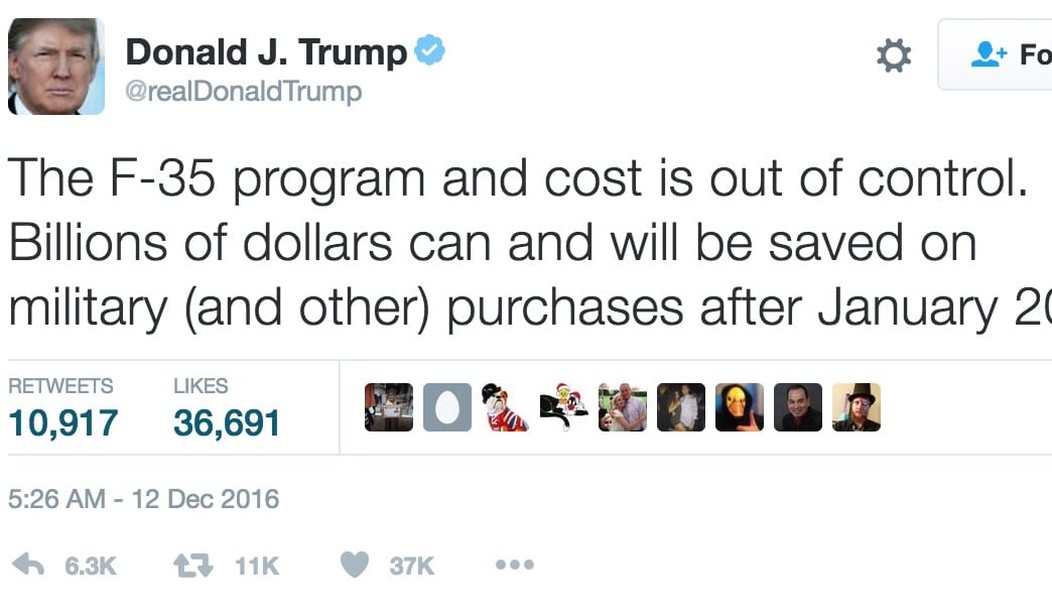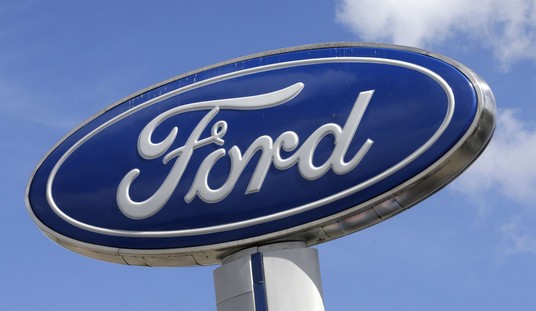Yesterday, Donald Trump fired this zinger off on Twitter
The F-35 program and cost is out of control. Billions of dollars can and will be saved on military (and other) purchases after January 20th.
— Donald J. Trump (@realDonaldTrump) December 12, 2016
It is really hard to disagree with this assessment. The F-35 started out as an “all-things-to-all-services” strike fighter that would reduce costs by replacing the F-16 (USAF), A-10 (USAF), F/A-18 (USN/USMC) and AV-8B (USMC) with a single airframe that had 80% of its parts in common. It would fight enemy fighters. It would duel with enemy air defense systems. It would bomb the snot out of ground targets. It would provide close air support at Danger Close distances to ground forces engaged in combat. But like anything else designed by a committee, it has become a monument to metastasizing cost overruns and poor performance. In fact, to call the program bloated and inefficient is to be kind. This is just stuff from the past couple of years as cataloged by Wikipedia:
A January 2014 report by J. Michael Gilmore said that new software delays could delay Block 2B release by 13 months.[148] This estimate was reduced to 4 months in the DOTE report from November 2014.[149] The F-35 program office considered software to be the top technical risk to the program. The USMC was maintaining their expectation of an Initial Operational Capability by July 2015.[150]
In 2014, U.S. Senator John McCain blamed cost increases in the program on “cronyism”.[151]
In 2014, the GAO found that the F-35 fleet would have operating costs 79% higher than the aircraft it was to replace.[152] In 2014, the FY2015 Selected Acquisition Report stated that the program cost had increased 43% from 2001, with Program Acquisition Unit Cost up 68% and Unit Recurring Flyaway up 41%.[153] The F-35A’s cost per flying hour in BY2012 dollars is $32,500 while the F-16C/D is $25,500, but each F-35A is expected to fly only 250 hours a year, compared to the F-16’s 316 hours a year, resulting in the same yearly operating cost.[153][154]
In December 2015, the FY2017 Selected Acquisition Report had revised the F-35A’s cost per flying hour in BY2012 dollars to $29,806, in comparison with the F-16C/D’s antecedent of $25,541, also in BY2012 dollars. This was a result of a decrease in the assumed cost per gallon of JP-8 fuel, a decrease in the fuel burn rate for the F-35A variant and a revised cost estimating relationship for hardware modifications.[155]
In July 2014, Lockheed Martin, Northrop Grumman, and BAE Systems announced they would invest a combined $170 million in the program[clarification needed], which was anticipated to result in savings of over $10 million per aircraft. This initiative was said to have set the project on track for an $80M (including engine) price tag per aircraft (F-35A) by 2018, when full production is scheduled to begin.[156]
The December 2014 Selected Acquisition Report listed a cost decrease of $7.5 billion against a program cost of $391.1 billion ($320 billion in 2012 dollars). Lockheed Martin also stated that there would be an estimated decrease of nearly $60 billion to the operations and support costs.[157]
The 2015 DoD annual report stated that the current schedule to complete System Development and Demonstration (SDD) and enter Initial Operational Testing and Evaluation (IOT&E) by August 2017 was unrealistic, instead the program would likely not finish Block 3F development and flight testing prior to January 2018. Based on those projected completion dates for Block 3F developmental testing, IOT&E would not start earlier than August 2018.[158][159]
The Block 3I software was intended to be a revision of the Block 2B software to run on the updated Integrated Core Processor.[160] Unfortunately, it resulted in a timing misalignment that reduced stability, requiring reboots in flight.[161] By May 2016 the software had been improved to the point where it only crashed every 15 hours.[162] Reboots were required over a third of the time for ground cold starts.[163] The following month saw 88 successful sorties untroubled by the stability bug.[164]
Trump’s criticism had a couple of immediate effects. First, Lockheed Martin’s stock nosedived:
Lockheed Martin lost as much as four percent of its total value in the moments after US president-elect Donald Trump tweeted that the cost of the military jet maker’s project to build advanced F-35 Lightning II fighters was “out of control.”
Panicked investors dumping stock initially shaved off around $3.5 billion (£2.75 billion) from the company’s value, though the share price had recovered somewhat by the close of trading on Monday, leaving it nearly 2.5 percent down on the previous day, or a dip of around $2 billion (£1.57 billion).
The second was Congressional outrage:
But Trump’s off-the-cuff remarks bristled others in Congress. Senator Richard Blumenthal, a Democrat from Connecticut, home to F-35 engine maker Pratt & Whitney, said the program supports 2,000 Pratt jobs and thousands more at suppliers.
“The suggestion that costs are out of control is just plain wrong,” he said. Trump should “learn more about the facts” before discussing “arbitrary cuts in the program,” he added. “He’s the president-elect. What he says matters.”
You will hear more of the latter because the real role of the F-35, at least from the view of a lot of members of Congress, is a milch cow for their districts:
Companies from 45 states are involved in the F-35’s production, with Texas, Georgia, California, Arizona and Florida playing the leading roles in testing and manufacturing the jet fighter. The company is teamed with more than 1,250 domestic suppliers to produce thousands of components ranging from highly sophisticated radar sensors to parts of the aircraft’s fuselage, according to Lockheed Martin.
And the defense industry (queue references to Eisenhower’s Military-Industrial-Congressional Complex) is heavily invested in the program proceeding, if not actually succeeding.
Just about every defense contractor except Boeing has exposure to the F-35 program. Northrop Grumman Corp., a major F-35 supplier, led an early slide in defense stocks after the president-elect’s latest attack on industry costs. Lockheed Martin and F-35 suppliers United Technologies Corp. and BAE Systems PLC also were lower.
Presidents are often urged to use their “bully pulpit” on issues. Rarely, though, does a president take on something his own administration will be managing. I’m not sure of what I think of this “management by Twitter” technique, but to give the devil his due, this single tweet, however, seems to have had more of an impact on the F-35 program than a decade of negative audits and investigations.













Join the conversation as a VIP Member